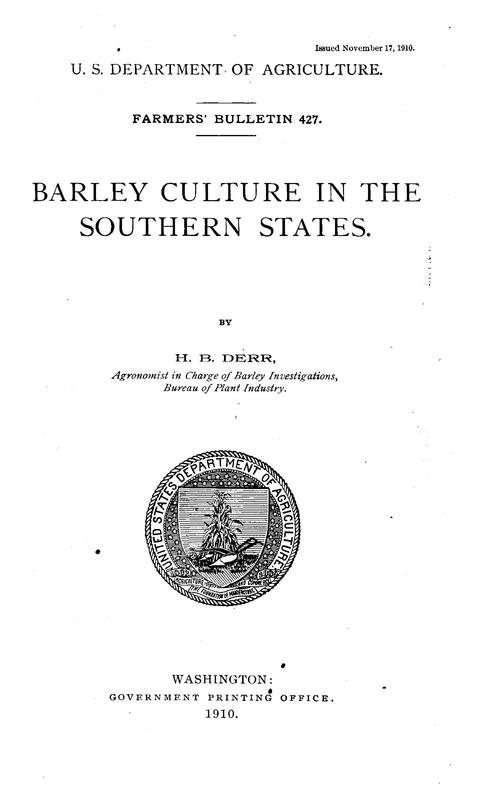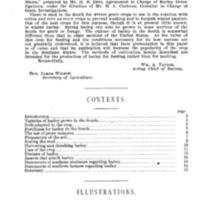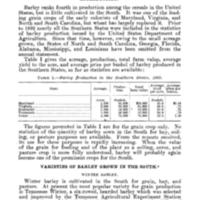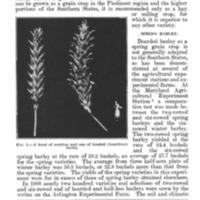Barley Culture in the Southern States
Creator
Date
1910
Excerpt
Barley, although it ranks fourth among the cereals in the United States, is but little cultivated in the South for grain.
As a true awnless barley has been developed the word "hooded" is proposed for the beardless barleys now grown.
The Tennessee Winter variety is the most profitable barley to grow in the South.
Winter hooded and spring hooded barleys are grown in only a few localities in the South.
The best soils for barley, either for grain or hay, are the fertile loams and clays.
Barley requires nitrogen, phosphoric acid, and potash to perfect the grain crop. The first, which is high priced, can be largely supplied by plowing under clover and cowpeas. This leaves only the cheaper fertilizers to be purchased.
Liming the soil has proved beneficial to barley.
Seed should be carefully selected before seeding to insure a good stand. The skimming process, when properly done, gives excellent results. Seed can be treated for smut in this operation.
The seed bed must be well prepared.
Barley will succeed best after a cultivated crop.
The time of seeding barley is regulated by the locality and elevation. A safe rule in the South is to sow winter barley before sowing winter wheat.
Spring barley to succeed in the South must be sown as early as possible.
As a true awnless barley has been developed the word "hooded" is proposed for the beardless barleys now grown.
The Tennessee Winter variety is the most profitable barley to grow in the South.
Winter hooded and spring hooded barleys are grown in only a few localities in the South.
The best soils for barley, either for grain or hay, are the fertile loams and clays.
Barley requires nitrogen, phosphoric acid, and potash to perfect the grain crop. The first, which is high priced, can be largely supplied by plowing under clover and cowpeas. This leaves only the cheaper fertilizers to be purchased.
Liming the soil has proved beneficial to barley.
Seed should be carefully selected before seeding to insure a good stand. The skimming process, when properly done, gives excellent results. Seed can be treated for smut in this operation.
The seed bed must be well prepared.
Barley will succeed best after a cultivated crop.
The time of seeding barley is regulated by the locality and elevation. A safe rule in the South is to sow winter barley before sowing winter wheat.
Spring barley to succeed in the South must be sown as early as possible.
Title
Barley Culture in the Southern States
File(s)
Barley Culture in the Southern States cover.jpg
(image/jpeg)
Barley Culture in the Southern States TOC.jpg
(image/jpeg)
Barley Culture in the Southern States 1.jpg
(image/jpeg)
Barley Culture in the Southern States 2.jpg
(image/jpeg)
 An official website of the United States government.
An official website of the United States government.





